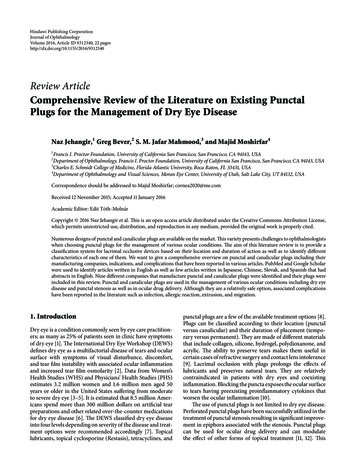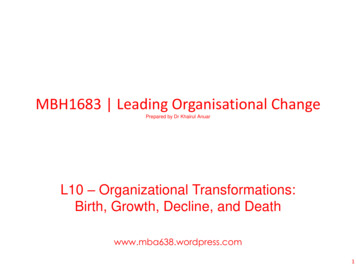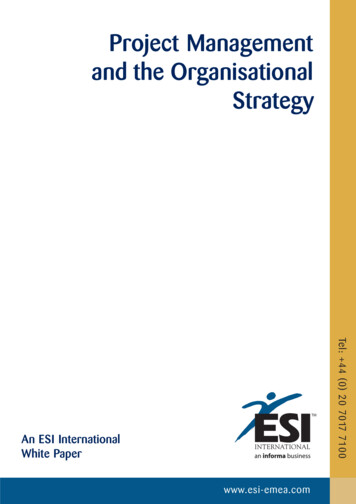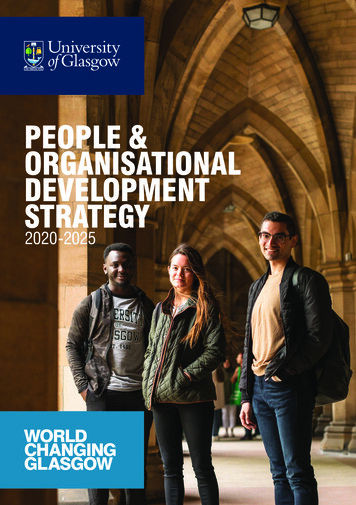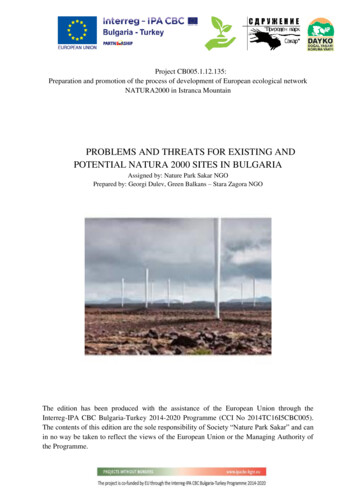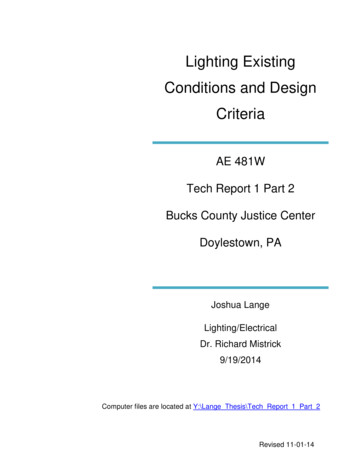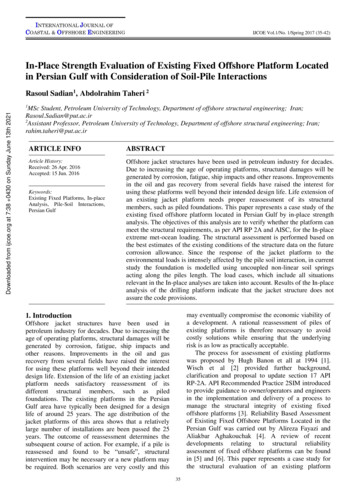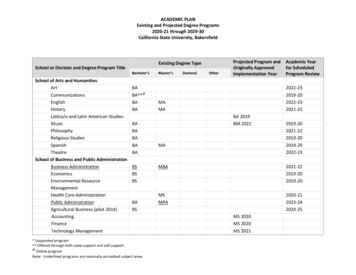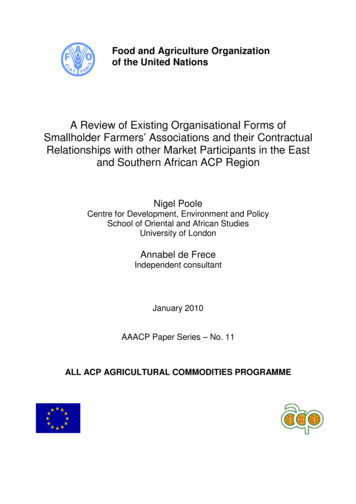
Transcription
Food and Agriculture Organizationof the United NationsA Review of Existing Organisational Forms ofSmallholder Farmers’ Associations and their ContractualRelationships with other Market Participants in the Eastand Southern African ACP RegionNigel PooleCentre for Development, Environment and PolicySchool of Oriental and African StudiesUniversity of LondonAnnabel de FreceIndependent consultantJanuary 2010AAACP Paper Series – No. 11ALL ACP AGRICULTURAL COMMODITIES PROGRAMME
AcknowledgementsThis document has been prepared as a contribution to the All ACP AgriculturalCommodities Programme with funding from the European Union, by Nigel Poole, Centrefor Development, Environment and Policy, School of Oriental and African Studies,University of London.It was commissioned by the Trade and Markets Division, FAO.DisclaimerThe views expressed in this working paper are those of the author and do not necessarilyreflect those of the Food and Agriculture Organization of the United Nations.2
PrefaceThis report was commissioned to inform interventions in support of processes of sectorstrategy initiated under the EU funded All ACP Agricultural Commodities Programme.More specifically, the purpose of this report is to review existing organizational forms ofsmallholder farmers’ associations and their contractual relationships with other marketparticipants considering the prevailing structure of sectoral value chains, drawing onvarious types of academic and other literature and experiences of project initiatives andpolicy interventions across a range of countries and sectors in the East and SouthernAfrican ACP region.In association with a related assessment of alternative mechanisms of state support tovalue chain development (see AAACP Paper Series No. 9), the review serves as acontribution towards the fulfilment of two key outputs specified in the project logframeof the EU AAACP, namely:(a) synthesis of options and diagnosis of the commodity chainsand livelihood systems analysis results; and (b) elaboration on the incorporation ofrelevant strategy recommendations and action plans into national development plansand policies in country specific cases.In practical terms, the two studies will form a basis of recommendations focussed onensure smallholder farmer participation in, and benefit from, the processes of valuechain development underway in the cassava sector in Zambia under the EU AAACP.The key insights from the experiences reviewed have been developed within aframework utilising transaction cost thinking and concepts from the organisation andbusiness development literature. They illustrate how, in African agricultural markets,‘institutional innovation’ is needed in respect of new ‘rules of the game’, and also newtypes of organisation, ie ‘new players in the game’, both within rural areas and also forlinking rural supply and urban consumption.The study argues that it is often small-scale institutional innovations in local marketorganisation and other non-price factors that are likely to stimulate smallholderparticipation in markets, particularly for staple foods in Africa. Efficient marketorganisation not only involves more but also better linkages between different economicplayers, which in turn require investment in various forms of human and social capital.3
On this basis, the report suggests that the international donor community can play a keyrole in system or sector-wide initiatives. Besides encouraging institutional innovations,specific investments in human and social capital and business and sectoral organisationare also needed to enable new ways of organising people and markets to work for thepoor - including agricultural smallholder collective enterprise.4
ContentsAcknowledgements . 2Disclaimer . 2Preface . 3Executive Summary . 712345Introduction . 121.1The development potential of better market organisation. 121.2Organisation of the report . 15Sectoral terms and context . 172.1Collaboration: terminology and rationale. 172.2Some theoretical considerations . 192.3Key insights . 302.4Synthesising a framework . 30A long view of agricultural cooperation . 343.1History and evolution of collective organisations . 343.2The political economy of agricultural collective organisation . 373.3Better marketing: public intervention or private initiative? . 413.4Supporting collective organisation? . 423.5A wider perspective: business services, chains and networks. 453.6The new models of cooperation. 463.7Key insights . 52Challenging external environments . 554.1Regulations and increasingly specific market demands . 554.2Consumer preferences . 564.3The rise of supermarkets in developing countries . 564.4Challenges and opportunities? . 574.5Key insights . 58Smallholder farmer associations in East and Southern Africa . 605.1Smallholder association environment analysis . 605.2Organisational typologies and organisational development . 635.3Mapping sector structure and organisation . 655.4Oromia Coffee Farmers Cooperative Union . 675.5National Smallholder Farmer’s Association of Malawi (NASFAM) . 685.6Collective and community-based management organisations. 715.7Participation and adaptation . 745.8Key insights . 765
67Contractual arrangements: seller-buyer linkages . 796.1Types of seller-buyer linkages . 796.2Independent producers. 816.3Contract farming. 826.4Enhanced private sector supply chain linkages. 846.5Case Study: Twin Trading Partnership . 906.6Key insights . 92Conclusions. 947.1Recapitulating collective weaknesses . 947.2Diagnostic and summary framework. 95References . 1016
Executive SummaryConsiderable changes have occurred in the global agricultural economy over the pastdecade. Growing urban demand in developing countries, greater influence of the privatesector in linking smallholder farmers to more dynamic markets, increasingly verticallycoordinated supply chains, a recognised need to support smallholders as a means oftackling poverty, and more stringent food safety standards are just a few of the issues.The recent dramatic food price increases have been attributed by commentators to avariety of sources – poor harvests in major producing regions, low stocks, depreciationof the US dollar, financial speculation, inappropriate energy policies and diversion ofagricultural production into biofuels, other linkages to non-agricultural trade andinvestment patterns. The rise of agricultural sector superpowers, such as some SouthAmerican countries in grains, sugar cane and other global commodities, has madeinternational markets more competitive. Climate change is already posing agroclimaticchallenges, and the probability of more severe impacts in the near future will exacerbatethe threats to producer livelihoods, particularly in marginal regions of developingcountries. Also, HIV/AIDS and migration are having complex effects on rural economies,not just changing the patterns of demand. Are smallholder farmers’ associations yetanother problem, or are they part of the solution to rural poverty?Often it is small-scale institutional innovations in local market organisation that are likelyto stimulate smallholder participation in input and output markets, particularly in staplefoods markets in Africa. ‘Institutional innovation’ is needed in respect of new ‘rules of thegame’ and new types of organisation, ie ‘new players in the game’, within rural areasand also for linking rural supply and urban consumption. So, too, are specificinvestments in human and social capital and business and market organisation: newways of organising both people and markets to work for the poor. Nevertheless, aresurgence of interest in farmer organisation, although coming at a time when there arerenewed goals for agriculture and the rural sector, is surprising: there has been a historyof organisational failure in many developing regions over the last two or three decades.A review of literature and experiences is timely: in order to look to the future, there is aneed to understand existing organisational forms of smallholder farmers’ associationsand their contractual relationships with other market participants within the context ofprevailing sectoral value chains in the East and Southern Africa ACP region. Specificexamples of smallholder farmers’ associations and their contractual arrangements areconsidered in this report. In the light of changing global contexts, we seek to providesome indication of best practice for policy on smallholder farmer associations to guide7
poverty reduction policies through potential intervention strategies for specific productsand markets.The fundamental question is how can better organisation of people and markets reducehunger, improve rural market performance and contribute to wider economic growth?The report tackles a series of issues concerning collective economic organisation in Africa.Potential unrealised?The historical outline of farmer associations in Africa that follows illustrates the diversityof group types, ranging from small informal farmer groups to large, tiered farmercooperatives, different sources and levels of initiatives and interventions, a variety ofcontexts, and changing policy approaches. A persistent theme in the literature is thatfarmer groups: Lack capital to grow in scale and complexity, particularly investment in physical assetsfor value addition through processing and manufacturing; Lack management capacity and good organisational governance; Compete in markets against economic forces that confound their traditionallybureaucratic and unresponsive structures and strategies.Besides internal organisational weaknesses and the lack of market competitiveness,unstable agricultural policies have created a disempowering external environment. As aresult, in general neither statutory nor voluntary forms of association and collectiveenterprise have generated significant and sustainable agribusinesses in Africa.Collective organisation: can it contribute to more equitable and efficient markets?There are theoretical explanations of the failures of collective organisation but at thesame time, the fundamental reasons for collaborating hold true: the potential forexploiting production and managerial economies of scale, overcoming market entrybarriers, reducing transaction costs and cultivating supply chain relationships. Collectivedecision making may be cumbersome, and top-down decision making may beundesirable. But new forms of collective enterprise illustrate that innovative businessmodels can work: ‘new generation cooperatives’ may provide solutions to some of thehistorical and structural problems of cooperatives. There are alternative managementstructures and financial resources - either philanthropic support; or external equityinvestment with a capacity to exert leverage through management building; orinvitations to bondholders with a financial stake but without governance rights. Thesestrategies offer the possibility of external capitalisation without diluting membershipcontrol.8
Despite a history of operational failure, statutory arrangements such as levies andmarketing boards are also mechanisms with potential to overcome market failures andthe provision of public goods. Also, much may be learnt also from experiences elsewhere,su
business development literature. They illustrate how, in African agricultural markets, . The historical outline of farmer associations in Africa that follows illustrates the diversity of group types, ranging from small informal farmer groups to large, tiered farmer cooperatives, different sources and levels of initiatives and interventions, a variety of contexts, and changing policy .
